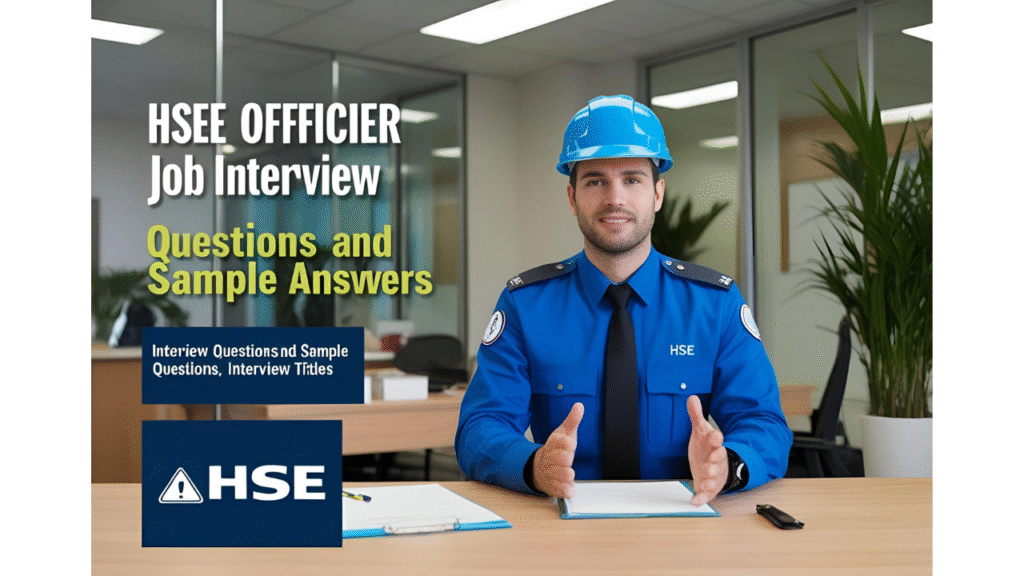
HSE Officer Job Interview Questions and Sample Answers
1. Can you introduce yourself and explain your HSE experience?
Sample Answer:
“I am a certified HSE professional with [X] years of experience in implementing safety policies, conducting risk assessments, and ensuring compliance with OSHA (or local) regulations. I have worked in industries such as [mention relevant industries], where I successfully reduced workplace incidents by [specific achievement].”
2. What are the key responsibilities of an HSE Officer?
Sample Answer:
“An HSE Officer is responsible for developing safety policies, conducting risk assessments, ensuring regulatory compliance, investigating incidents, providing safety training, and promoting a culture of safety in the workplace.”
3. How do you ensure compliance with health and safety regulations?
Sample Answer:
“I stay updated with local and international safety regulations, conduct regular audits, implement corrective actions, and provide training to employees to ensure compliance. I also maintain documentation for legal and certification purposes.”
4. Can you describe a time when you identified a safety hazard and resolved it?
Sample Answer:
“At my previous job, I noticed that workers were not using proper PPE while handling chemicals. I organized a training session, enforced PPE compliance, and introduced safety checklists, which reduced chemical exposure incidents by 30%.”
5. How do you conduct a risk assessment?
Sample Answer:
“I follow a structured approach: identify hazards, assess the level of risk, implement control measures, and review effectiveness. I use tools like JSA (Job Safety Analysis) and HIRA (Hazard Identification and Risk Assessment) to ensure thorough evaluation.”
6. What steps do you take in case of a workplace accident?
Sample Answer:
“First, I ensure immediate medical attention for the injured. Then, I secure the area, document the incident, conduct a root cause analysis, and implement corrective actions to prevent recurrence. I also report the incident as per legal requirements.”
7. How do you promote a safety culture in the workplace?
Sample Answer:
“I encourage open communication about safety concerns, recognize safe behaviors, conduct regular training, and involve employees in safety committees. Leading by example and fostering accountability are key.”
8. What is your experience with safety audits and inspections?
Sample Answer:
“I have conducted internal and external safety audits, identified non-compliance issues, and recommended corrective actions. I use checklists and regulatory standards to ensure thorough inspections.”
9. How do you handle employees who resist following safety protocols?
Sample Answer:
“I explain the risks and consequences of non-compliance, provide additional training if needed, and enforce disciplinary actions as a last resort. Building trust and demonstrating the importance of safety usually works.”
10. What are the most common workplace hazards, and how do you mitigate them?
Sample Answer:
“Common hazards include slips/trips, electrical hazards, and chemical exposure. I mitigate them through proper signage, PPE enforcement, regular equipment maintenance, and employee training.”
11. How familiar are you with OSHA (or local safety) regulations?
Sample Answer:
“I am well-versed in OSHA standards (or local regulations) such as hazard communication, fall protection, and emergency action plans. I ensure compliance through regular reviews and updates to company policies.”
12. What safety training programs have you conducted?
Sample Answer:
“I have conducted fire safety, first aid, hazardous material handling, and emergency evacuation drills. I tailor training to specific workplace risks and ensure engagement through interactive sessions.”

13. How do you investigate a near-miss incident?
Sample Answer:
“I treat near-misses seriously by documenting details, interviewing witnesses, analyzing root causes, and implementing preventive measures to avoid future incidents.”
14. What is the importance of PPE, and how do you ensure its proper use?
Sample Answer:
“PPE is the last line of defense against hazards. I ensure proper use by providing training, enforcing policies, and conducting regular checks to verify compliance.”
15. How do you stay updated with the latest HSE trends and regulations?
Sample Answer:
“I attend industry seminars, subscribe to safety newsletters, participate in professional networks, and take refresher courses to stay informed.”
16. Can you explain the hierarchy of controls in hazard management?
Sample Answer:
“The hierarchy is: Elimination (remove hazard), Substitution (replace hazard), Engineering Controls (isolate hazard), Administrative Controls (change work practices), and PPE (last resort).”
17. How do you handle emergency preparedness and response?
Sample Answer:
“I develop emergency response plans, conduct regular drills, train employees on evacuation procedures, and ensure emergency equipment is accessible and functional.”
18. What environmental regulations do you consider in your HSE role?
Sample Answer:
“I ensure compliance with waste disposal, air/water pollution control, and hazardous material handling regulations such as EPA (or local) standards.”
19. How do you measure the effectiveness of your HSE programs?
Sample Answer:
“I track KPIs such as incident rates, near-miss reports, audit findings, and employee feedback to assess effectiveness and make improvements.”
20. What is your approach to contractor safety management?
Sample Answer:
“I ensure contractors follow site safety rules by conducting orientations, reviewing their safety records, and monitoring their compliance during work.”
21. How do you deal with conflicting priorities between safety and productivity?
Sample Answer:
“Safety is non-negotiable. I work with management to find solutions that ensure safety without compromising productivity, such as optimizing work processes.”
22. What software or tools do you use for HSE management?
Sample Answer:
“I have used tools like MSDS databases, incident reporting software (e.g., Intelex), and risk assessment tools to streamline HSE processes.”
23. How do you ensure mental health and well-being in the workplace?
Sample Answer:
“I promote work-life balance, provide stress management resources, and encourage open discussions about mental health to create a supportive environment.”
24. What would you do if you discovered a serious safety violation by senior management?
Sample Answer:
“I would document the issue, present evidence of the risks, and escalate it through proper channels while suggesting corrective actions.”
25. Why should we hire you as our HSE Officer?
Sample Answer:
“I bring a proven track record in reducing workplace incidents, strong regulatory knowledge, and a proactive approach to safety. My goal is to ensure a zero-harm workplace while aligning with your company’s objectives.”






















